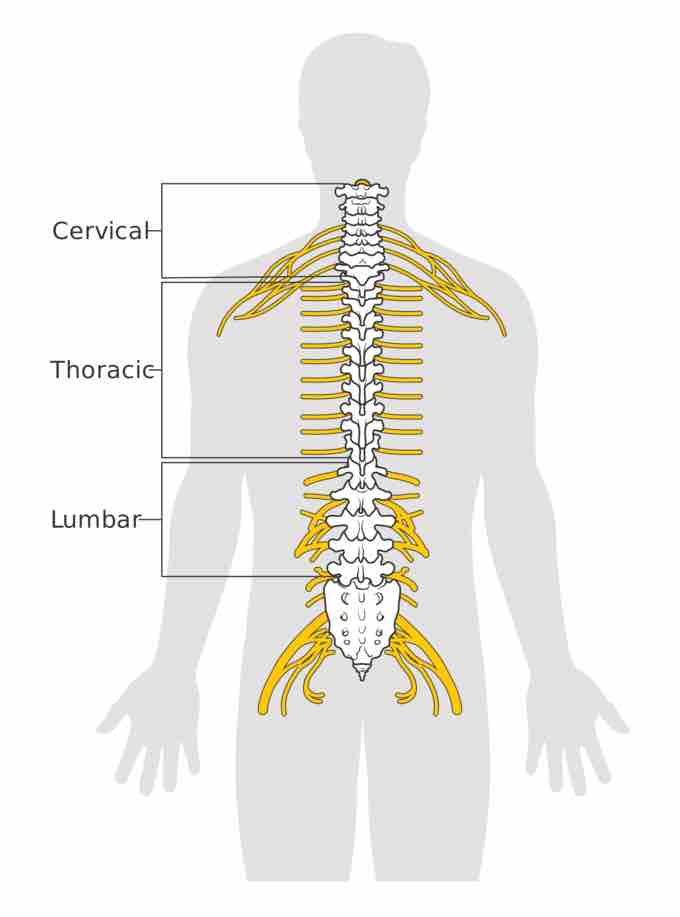The spinal cord is a long, thin, tubular bundle of nervous tissue and support cells that extends from the medulla oblongata of the brain to the level of the lumbar region. The brain and spinal cord together make up the central nervous system (CNS). The spinal cord, protected by the vertebral column, begins at the occipital bone and extends down to the space between the first and second lumbar vertebrae. The spinal cord has a varying width, ranging from 0.5 inch thick in the cervical and lumbar regions to 0.25 inch thick in the thoracic area. The length of the spinal cord is approximately 45 cm (18 in) in men and about 43 cm (17 in) long in women.

Spinal Cord and Vertebrae.png
Relationship between the spinal cord and vertebral column, delineating the cervical, thoracic, and lumbar sections.
Layers and Regions of the Spinal Cord
The spinal cord is protected by three layers of tissue called meninges and divided into three regions.
Spinal Cord Tissue Layers
The dura mater is the outermost layer of spinal cord tissue, forming a tough protective coating. The space between the dura mater and the surrounding bone of the vertebrae is called the epidural space. The epidural space is filled with adipose tissue and contains a network of blood vessels. The middle layer is called the arachnoid mater. The pia mater is the innermost protective layer and is tightly associated with the surface of the spinal cord. The space between the arachnoid and pia maters is called the subarachnoid space and is where the CSF is located. It is from this location at the level of the lumbar region that CSF fluid is obtained in a spinal tap.
Spinal Cord Regions
In cross-section, the peripheral region of the cord displays neuronal white matter tracts containing sensory and motor neurons. Internal to this peripheral region is the gray, butterfly-shaped central region made up of nerve cell bodies. This central region surrounds the central canal, which is an anatomic extension of the spaces in the brain known as the ventricles and like the ventricles, contains cerebrospinal fluid.

Spinal Cord Regions
Cross-sectional perspective of the spinal cord regions
The spinal cord is divided into cervical, thoracic, and lumbar regions. The cervical region is divided into eight levels that are related to different motor and sensory functions in the neck and the arms. The spinal nerves of the thoracic region supply the thorax and abdomen. The nerves of the lumbosacral spinal cord supply the pelvic region, legs, and feet.
Spinal Cord Nerve Branches
Thirty-one pairs of spinal nerves (sensory and motor) branch from the human spinal cord. Each spinal nerve is formed from the combination of nerve fibers from its posterior and anterior roots. The posterior root is the sensory (afferent) root that carries sensory information to the brain from other areas of the body. The anterior root is the motor (efferent) root that carries motor information to the body from the brain.
The spinal nerve emerges from the spinal column through the opening (intervertebral foramen) between adjacent vertebrae. An exception is the first spinal nerve pair (C1), which emerges between the occipital bone and the atlas (the first vertebra). The swelling found in the posterior root is the posterior (dorsal) root ganglion, which contains the cell bodies of sensory neurons. The anterior (ventral) root contains axons of motor neurons that conduct nerve impulses from the CNS to other parts of the body such as the muscles.
The cauda equina ("horse's tail") is the name for the collection of nerves in the vertebral column that extends beyond the cord. The nerves that compose the cauda equina supply the pelvic organs and lower limbs, including motor innervation for the hips, knees, ankles, feet, and internal and external anal sphincters. In addition, the cauda equina extends to sensory innervation of the perineum.
Primary Spinal Cord Function
The spinal cord functions primarily in the transmission of neural signals between the brain and the rest of the body, but it also contains neural circuits that can independently control numerous reflexes and central pattern generators. The three major functions of the spinal cord are the conduction of motor information traveling down the spinal cord, the conduction of sensory information in the reverse direction, and acting as the center for conducting certain reflexes. The spinal cord is the main pathway for information connecting the brain and peripheral nervous system.